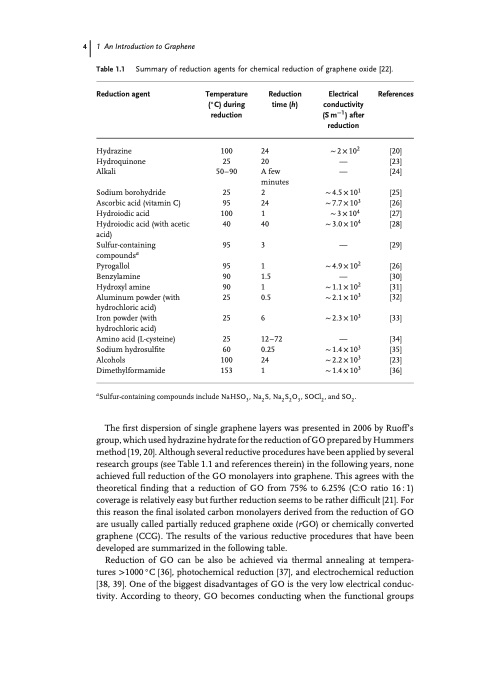
PDF Publication Title:
Text from PDF Page: 004
4 1 An Introduction to Graphene Table 1.1 Summary of reduction agents for chemical reduction of graphene oxide [22]. Reduction agent Hydrazine Hydroquinone Alkali Sodium borohydride Ascorbic acid (vitamin C) Hydroiodic acid Hydroiodic acid (with acetic acid) Sulfur-containing compoundsa Pyrogallol Benzylamine Hydroxyl amine Aluminum powder (with hydrochloric acid) Iron powder (with hydrochloric acid) Amino acid (L-cysteine) Sodium hydrosulfite Alcohols Dimethylformamide Temperature (◦C) during reduction 100 25 50 – 90 25 95 100 40 95 95 90 90 25 25 25 60 100 153 Reduction time (h) Electrical conductivity (S m−1 ) after reduction References 24 ∼2×102 [20] 20— [23] Afew — [24] minutes 2 24 1 40 3 1 1.5 1 0.5 6 12–72 0.25 24 1 ∼4.5× 101 [25] ∼7.7× 103 [26] ∼3× 104 [27] ∼3.0× 104 [28] — [29] ∼4.9×102 [26] — [30] ∼1.1×102 [31] ∼2.1×103 [32] ∼2.3×103 [33] — [34] ∼1.4×103 [35] ∼2.2×103 [23] ∼1.4×103 [36] aSulfur-containing compounds include NaHSO3, Na2S, Na2S2O3, SOCl2, and SO2. The first dispersion of single graphene layers was presented in 2006 by Ruoff’s group, which used hydrazine hydrate for the reduction of GO prepared by Hummers method [19, 20]. Although several reductive procedures have been applied by several research groups (see Table 1.1 and references therein) in the following years, none achieved full reduction of the GO monolayers into graphene. This agrees with the theoretical finding that a reduction of GO from 75% to 6.25% (C:O ratio 16 : 1) coverage is relatively easy but further reduction seems to be rather difficult [21]. For this reason the final isolated carbon monolayers derived from the reduction of GO are usually called partially reduced graphene oxide (rGO) or chemically converted graphene (CCG). The results of the various reductive procedures that have been developed are summarized in the following table. Reduction of GO can be also be achieved via thermal annealing at tempera- tures >1000◦C [36], photochemical reduction [37], and electrochemical reduction [38, 39]. One of the biggest disadvantages of GO is the very low electrical conduc- tivity. According to theory, GO becomes conducting when the functional groupsPDF Image | An Introduction to Graphene

PDF Search Title:
An Introduction to GrapheneOriginal File Name Searched:
352733551X-c01.pdfDIY PDF Search: Google It | Yahoo | Bing
Salgenx Redox Flow Battery Technology: Power up your energy storage game with Salgenx Salt Water Battery. With its advanced technology, the flow battery provides reliable, scalable, and sustainable energy storage for utility-scale projects. Upgrade to a Salgenx flow battery today and take control of your energy future.
| CONTACT TEL: 608-238-6001 Email: greg@infinityturbine.com | RSS | AMP |